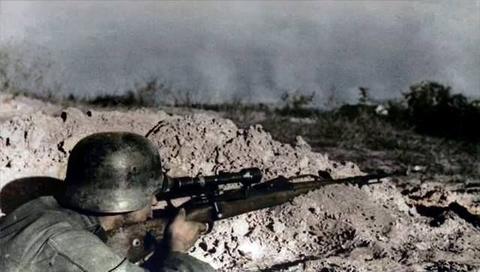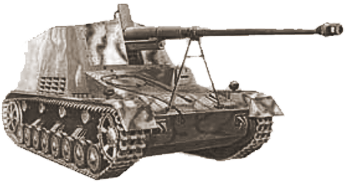Stalingrad: Opposing Forces Early in September 1942

During the summer of 1942 Hitler and OKH had split Germany's Army Group South in two. Army Group A represented the linchpin of the German strategic effort. Army Group A's objectives included the Maikop oil fields (captured during August, albeit after being thoroughly demolished), the Grozny oil refineries, and the Baku oil fields. Together, these oil fields and refineries constituted the overwhelming majority of the Soviet Union's sources of oil. Had the Germans even been able to sever Soviet access to or use of these resources it would have potentially crippled the Red Army's offensive strength at a time when it was becoming increasingly mechanized and ever more reliant on access to abundant oil reserves. This mechanization was part of the desperate Soviet effort to stop in particular the German panzer divisions that had done so much damage to date in the war. In spite of the fact the Caucasian oil fields might have represented at that time the most important target in the world, by the first week of September 1942 Army Group A fielded only about 300,000 German and Axis allied troops.
Meanwhile, Army Group B stood as the second grouping to emerge from the summer split in Army Group South. Army Group B's primary objective had shifted during July of 1942 from not just protecting Army Group A's flank but to include capturing Stalingrad. Though Stalingrad ranked as an important objective, it's significance paled in comparison to that of the Soviet oil fields and refineries in the Caucuses. Nevertheless, perhaps because of this "mission creep" (to use today's terminology), by September 3, 1942 Army Group B was an offensive juggernaught dwarfing Army Group A in almost every measure. Army Group B included five Axis armies (the German Second Army, Second Hungarian Army, Eighth Italian Army, German Sixth Army, and German Fourth Panzer Army) totalling 980,000 men (580,000 German and 400,000 Axis allied troops).
The German Sixth Army respresented Army Group B's spearhead. It held over one fifth of the Army Group's strength, with approximately 200,000 men deployed in four army and one panzer corps. However, and as previously described, the bulk of the army's power (three army corps and the XIV Panzer Corps single panzer and two motorized divisions) was occupied with defending the southern bank of the Don River stretching north and northwest of Stalingrad. Meaning that on September 3, 1942 only three German corps carried the initial assault into Stalingrad. These included the Sixth Army's LI Army Corps (71st, 295th, and 389th infantry divisions) and the Fourth Panzer Army's XXXXVIII Panzer and IV Army Corps (94th Infantry, 29th Motorized, 14th and 24th Panzer Divisions and the Romanian 20th Infantry Division). Throughout the battle for Stalingrad these 80,000 combat troops received reinforcement or relief from just three German infantry divisions; the 79th, 100th Jager, and 305th; along with a host of lesser formations. In fact, as of September 12th the German Sixth Army and Fourth Panzer Army together had 27 total divisions and yet only were able to deploy only six full divisions and parts of three others in the city.
The armored component of Sixth Army and Fourth Panzer Army included approximately 275 tanks at that time (most sources range between estimates of 250 and 300 panzers in operating order within the two armies). The German 22nd and 16th Panzer Divisions ranked as the strongest. Each fielded around 65 tanks. Meanwhile, the 14th and 24th Panzer Divisions could only field approximately 35-40 tanks apiece. The 3rd, 29th, and 60th Motorized Divisions each had around 25 tanks in running condition. In addition, the 177th, 244th, and 245th assault gun battalions deployed around forty assault guns. What is most striking about this is that in spite of each German panzer division's paper weakness the 24th Panzer Division in particular would play a critical role in achieving the biggest gains within the city during the crucial months of September and October; showing what one understrength panzer divisions could accomplish. All of which leaves us to wonder what would have happened had even one more panzer division been available at any point during these weeks. Alternatively, we could also imagine what it would have meant had the 24th Panzer Division merely been as lavishly equipped and regularly reinforced as the two panzer divisions then stalemated outside El Alamein - where they would sit and accomplish virtually nothing at great logistical expense for the better part of three months during the late summer and fall of 1942.
Beyond the mixed state of the Sixth Army's armored park however was it's manpower. Because of German command decisions (most notably the order to break from Blue's original plan and launch the drive on the Volga contemporaneously with Army Group A's push into the Caucuses) the Sixth Army had largely been forced to fight on its own throughout much of late July and August of 1942. In addition, it had hardly received any kind of priority in terms of resupply no less replacing manpower. Of course this was true of Army Group B as a whole. In spite of playing perhaps the key role in the entire campaign (as its ability to set a hard defensive shoulder and do so quickly would determine how much additional support could be released to support Army Group A's push into the Caucuses) the German command consistently failed to give it priority in terms of personall replacements during the summer of 1942. For instance, in July the Army Group sustained 30,827 casualties and yet in turn was given only 19,400 replacement personnel. Things got even worse in August when Army Group B suffered 49,225 casualties but only got back 13,000 replacements (of which 7,589 men went to the German Second Army leaving only 5,411 men for the rest of the army group). The total replacements going to the army group represented only on average 12.5% of the replacements going to the Ostheer in the summer of 1942 even though Army Group B had taken one third of the Ostheer's total casualties for July and August. As a result the Sixth Army spent the better part of six weeks clearing Soviet reinforcements rushed to the region in and around the great bend in the Don River west of Stalingrad. Something that the Germans could have easily avoided had they stuck to Blue's original plan and supported Sixth Army with the Fourth Panzer Army whom it had been paired with throughout much of Blue's initial month. As a result and though the Sixth Army had still routed the Stalingrad Front the inexperienced but courageous and determined Soviet defensive effort not only had slowed the Sixth Army's drive on Stalingrad but inflicted substantial casualties on Paulus' command.
For instance, from July 21 to September 10th the Sixth Army suffered 47,248 casualties. This meant that though the overall size of the Sixth Army was substantial a quarter of its infantry 103 infantry battalions were already so weak as to be classified as largely incapable of offensive combat operations. The 100th Jager Division that would eventually be on the key reinforcements sent into Stalingrad was already so hard hit its organic complement of six infantry battalions had been consolidated into three. Moreover, the Fourth Panzer Army's German formations had similarly suffered significant manpower losses. The 14th Panzer, 29th Motorized Infantry, and 94th Infantry Division had by the middle of September already endured 1,533 casualties (the 14th Panzer), 1,911 casualties (29th Motorized), and 3,128 casualties (94th Infantry albeit with its losses including those sustained since Blue began in June). This meant that the Sixth Army and elements of Fourth Panzer Army involved in the fight for the city needed to move exceedingly fast to take Stalingrad otherwise a slugfest would not work in their favor given their already weakened state.
In opposition stood primarily the Soviet Stalingrad and Southeastern Fronts totalling eight armies and 550,000 men. The Soviet armies were supported by around 600 tanks. The 4th, 7th, and 16th Tank Corps could each field around 100 tanks, the 22nd and 28th Tank Corps around 75 tanks each, 13 tanks in 23rd Tank Corps, and the rest of the armor in the 2nd Tank Corps as well as numerous independent tank brigades and battalions. However, as much of this armor comprised light tanks as it did the harder hitting T-34 medium and KV-1 heavy tanks.
Though the Red Army had more armor on hand, the German dominated the air with 950 aircraft in opposition to only 226 Soviet machines. It would be interesting to compare Luftflotte Four's reduced line strength (having begun Operation Blau with 1,600 aircraft) to the large air fleet's the Axis maintained at that time in the Mediterranean theater of operations. The German air force in the Mediterranean had been bolstered even though by September of 1942 it was long past the point Rommel's drive into Egypt had sputtered to a halt with no obvious way to refresh it's eastward push to the Suez Canal against the growing power of the British Commonwealth army in opposition. A drive that not incidentally had no hope of bringing the short-term strategic gains to the German war position that either the seizure of Stalingrad or elimination of the Soviet oil fields in Southern Russia could have accomplished. Finally, one other point must be made about the opposing forces in and around Stalingrad.
As discussed in several previous posts on the fighting against Sixth Army's flanks the majority of the Soviet combat power in the region remained outside Stalingrad throughout the battle. The continually reinforced Soviet 62nd Army carried the burden for defending the city proper. The 62nd Army averaged around 50,000 men throughout the September to November fighting. It's strength dipped lower during times of crisis brought on by the intense German assaults within the city, and climbed slightly higher when Stavka fed in reinforcements to keep the army strong enough to absorb German attention and bleed away the Sixth Army's fighting power. As it was and during the battle the Red Army would, in terms of reinforcements, maintain the 62nd Army's strength with not only tens of thousands of men but an additional nine rifle divisions and five independent tank or rifle brigades. All of which was done while the Soviet command also assembled powerful reserves on the steppe northwest and southeast of the city.



Post new comment